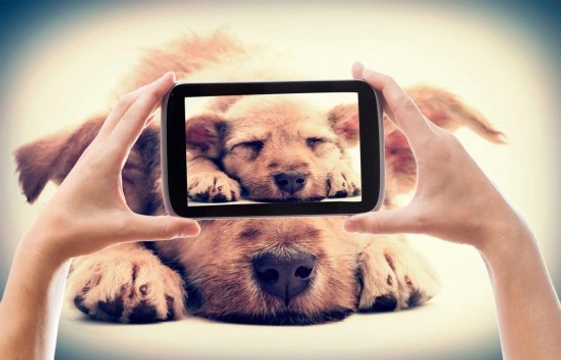
How to get your dog to cooperate for photographs
Most of us are only too familiar with the concept of trying to get a good picture of our dogs, only to spend ages working on it just to end up with a blur of fur, a side view of a wagging tail, or your dog deliberately looking the other way or scratching their butt!
If you despair of ever getting a simple, good clear photo of your dog and are on the verge of giving up, don’t lose heart! Getting a good basic image of your dog shouldn’t be impossible, assuming that your dog is well versed in the training basics and relatively responsive. If you still haven’t lost hope of taking that family shot with your dog or sending out a funny Christmas card of your dog in their hat but are running into difficulties, we have some advice for you on how to get your dog to cooperate for basic photographs.
Read on to learn more!
Master the sit
Basic portrait shoots involve keeping your dog still, which can be easier said than done! Whether you want your dog to sit or stand for their shot, make sure that you have a command that your dog recognises and will respond to, otherwise your shoot is going to be doubly challenging from the get-go!
Get your dog to sit or stand where you want them to, and to remain in place for a couple of minutes, and you’re off to a head start.
Master the stay
Your dog might sit or stand quite happily while you are there, but will they keep still when you move away from them to set up your camera angle? As well as mastering the sit or standing posture you wish your dog to attain, don’t forget to get the “stay” down to pat as well, or by the time you click the shutter, your dog may be off on their own!
Get your dog to look at you
So you’ve got the sit and the stay; but your dog is looking anywhere but at you? Getting your dog’s attention comes next. Wait until the very last moment before you take your shot to get your dog’s attention, as their direct look in your direction may be fleeting! Rustle a treat bag (unless your dog will automatically get up to see what you have) make a funny noise, or have someone standing behind you drawing your dog’s attention. Keep praising your dog and give them treats as you go along, to hold their interest and keep them from getting bored.
Beware the flash
Using the flash function on your camera can cause your dog to blink, close their eyes or otherwise respond, and possibly, it will frighten or upset them. See how your dog responds to the flash, but consider other options with natural lighting so that you do not have to use the flash to get your picture.
What camera mode to use
Even the most basic of cameras and camera phones generally have a range of different settings for photographing different things, so pick the right setting to get your shot of your dog. Standard portrait mode is usually fine, but if you dog’s tail is wagging furiously and you want to get a clear shot rather than a whirring blur, consider using an action mode, or a setting that takes several images in quick succession.
Get your dog used to any accessories first!
If you’re planning to dress your dog up in a funky hat or anything else, don’t introduce these things to your dog for the first time when you grab the camera. Getting your dog to behave for a picture can be challenging all on its own, and putting your dog in an outfit that they are not used to will only add to the stimulus and confusion that can make getting your picture hard!
Let your dog see, play with and wear anything you want to use in your pictures ahead of time, and don’t plan your photo shoot until your dog is used to them and comfortable with them, or will at least tolerate them for a few minutes at a time!
Keep the session short
Setting up where you want to take your picture, the camera settings and everything else can take some time, so don’t make your dog hang around getting bored while you do this! Get everything ready before you get your dog involved, and keep the session with your dog there short- ten minutes at most. If you don’t get your shot in this time, be prepared to call it quits and try another day, particularly if your dog is getting fed up.
Praise your dog, keep talking to them and give them treats while you go about things, and don’t get annoyed or frustrated with your dog if things don’t go to plan- after all, your dog can hardly be expected to know what you are doing!



